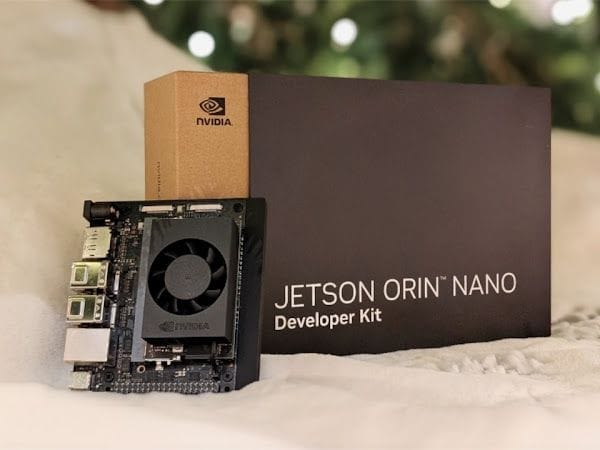NVIDIA Jetson Orin Nano Super Developer Kit lies in a new level of edge computing devices which featuring compact and energy efficiency with powerful AI performance. NVIDIA uses the basic and extended versions of the earlier employed Ampere architecture with from 1024 CUDA cores, 6-core Arm Cortex-A78AE v8.2 CPU. The system layout alongside the anoint 8GB LPDDR5 supports an AI performance of up to 40 TOPS with a power rating of 7W – 15W.
Connectivity & I/O
But, from a product design perspective, the overall outlook of the kit juxtaposes flexibility and connection points. Some of the ports you find here are the Gigabit Ethernet, mutiple USB 3.2 and 2.0 ports, and HDMI output port. GPIO, I2C, SPI, UART headers, and M.2 slots for wireless and NVMe make it a nice development board for researchers and developers in the IoT edge AI sector.

Software Ecosystem
The Jetson Orin Nano runs on Ubuntu-based Linux for Tegra (L4T), and is packed with NVIDIA’s JetPack SDK, which gives developers a rich set of tools and libraries. The software platform and supports popular deep learning frameworks such as PyTorch, TensorFlow and ONNX- Runtime all tuned for the platform. As implemented in this project, this set of tools helps to optimize both AI application development and the deployment process, especially concerning LLMs.
Development Tools
- NVIDIA Container Runtime
- Docker support
- TensorRT optimization
- CUDA toolkit
- Deep learning frameworks support:
- PyTorch
- TensorFlow
- ONNX Runtime
The area of LLM capability is quite admirable in the platform. The Jetson Orin Nano can handle leaner LLMs consisting of quantized version of LLaMA 2, Mistral 7B, TinyLlama, and GPT-2 & BERT minis. These models can be optimized by different methods of Int8 quantization, FP16 precision, model pruning, and knowledge distillation. The integration with TensorRT brings inference even faster making real-time language processing possible on the edge.
LLM Capabilities
Performance optimisation on the Jetson Orin Nano demands the careful management of resources and their consumption. In the case of the LLM workloads, which were described in this paper, the system provides very fast inference rates: approximately 100ms for GPT-2 Small and 50ms for BERT-base. Memory consumption remains fairly standard and ranges from 2GB to 6GB based on added model sizes for the training models; CPU and GPU usage remain moderate under pressure, normally, varying between 40% and 90%. A number of performance measurements have been putting the platform in various practical usages in industrial automation, smart retail, and health care fields.
LLM Inference Speed
- GPT-2 Small: ~100ms per inference
- BERT-base: ~50ms per inference
- Custom quantized models: 30-80ms range
LLM Deployment
Heavens deploying LLMs on the platform is an easy process; I must confess it calls for elaborate planning and execution. In general, the user starts with the installation of JetPack SDK as well as environments for the desired deep learning framework. Therefore, model optimization is a critical step in the current implementation to ensure the best results are obtained. This includes right quantization strategies, capturing with TensorRT, necessary controls like gradient checkpointing and right caches management.

Real-World Applications
This is demonstrated particularity well by the fact that the developer kit performs well operationally in numerous fields of industry. It can power natural language control systems at industries and prediction of equipment failures at industries. Other applications are smart retail since they use its capacity to execute customer service chatbots and real-time analytics systems. In healthcare, the platform is used to provide medical text analysis as well as patient interaction solutions and provide data privacy through edge processing.
Subsequent care and development are easy with updates to the entire system, increases to the driver base, and improvements to the SDK. The thermal management and power costs characteristics of the platform also allow it to operate continuously at different environments. Freagus and checks performed on system logs, temperature as well as on models make it easy to change undesirable system behavior before it affects the production systems.
Upcoming Features
Moving forward, the Jetson Orin Nano platform remains in development now. Promising additions that we anticipate are the integration with richer language models, the refinement of the quantization methods, and the optimization of power consumption. This makes the platform flexible and has a strong ecosystem for growth to tailor in new applications of autonomy in systems, smart city constructs, and progressive learning instruments.
Maintenance and Updates
Although it seems to have constraints in comparison to cloud-based solutions – most notably regarding managing very large LLMs – its capacity to run highly effective versions of widely used LLMs makes it an incredibly useful tool in edge computing contexts. The synergy of Arm-based processors, endeavouring software, and coverage of development tools present a convincing proposition to companies interested in deploying AI smarts to the edge while keeping data local and time-sensitive.
The NVIDIA Jetston Orin Nano Super Developer Kit therefore serves as a beacon on the constant evolution of edge AI Computing. Its efficiency and optimisation being preserved even at complex LLM projects, make it ideal as a platform for developers and organisations who want to explore the edge AI advancements.
Conclusion
The NVIDIA Jetson Orin Nano Super Developer Kit is a new landmark in AJT for acting as an optimal platform for LLM deployment. Its feature of powerful hardware coupled with optimized software stack and rich tool chain makes it very suitable for deployment of edge AI use cases. Despite the fact that its model size and computation power is limited compared to cloud services, having optimized, quantized versions of several popular LLMs makes it an useful instrument for edge computation cases.


2 thoughts on “NVIDIA Jetson Orin Nano: Revolutionizing Edge AI and LLM Deployment , 1.7x leap”